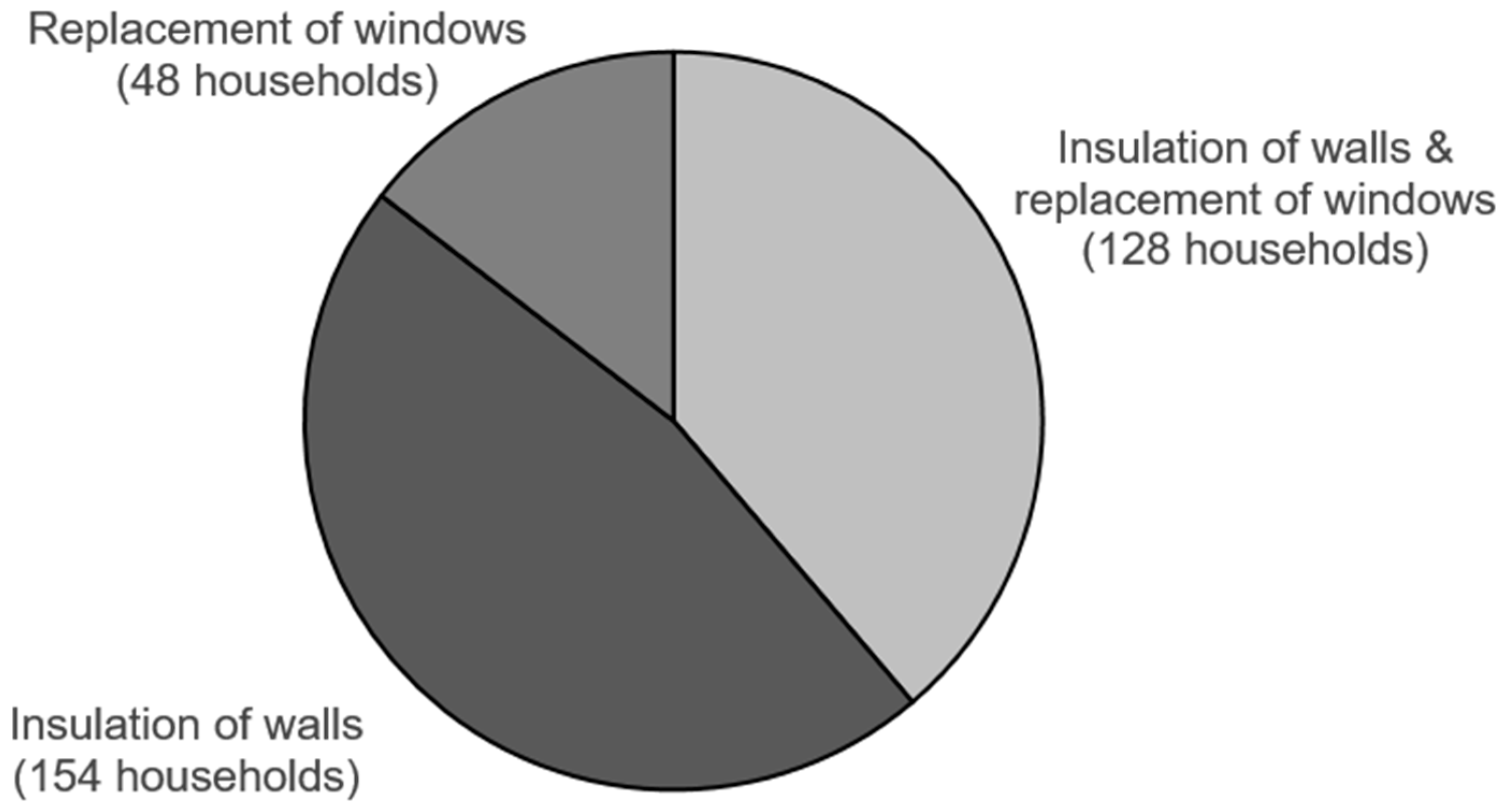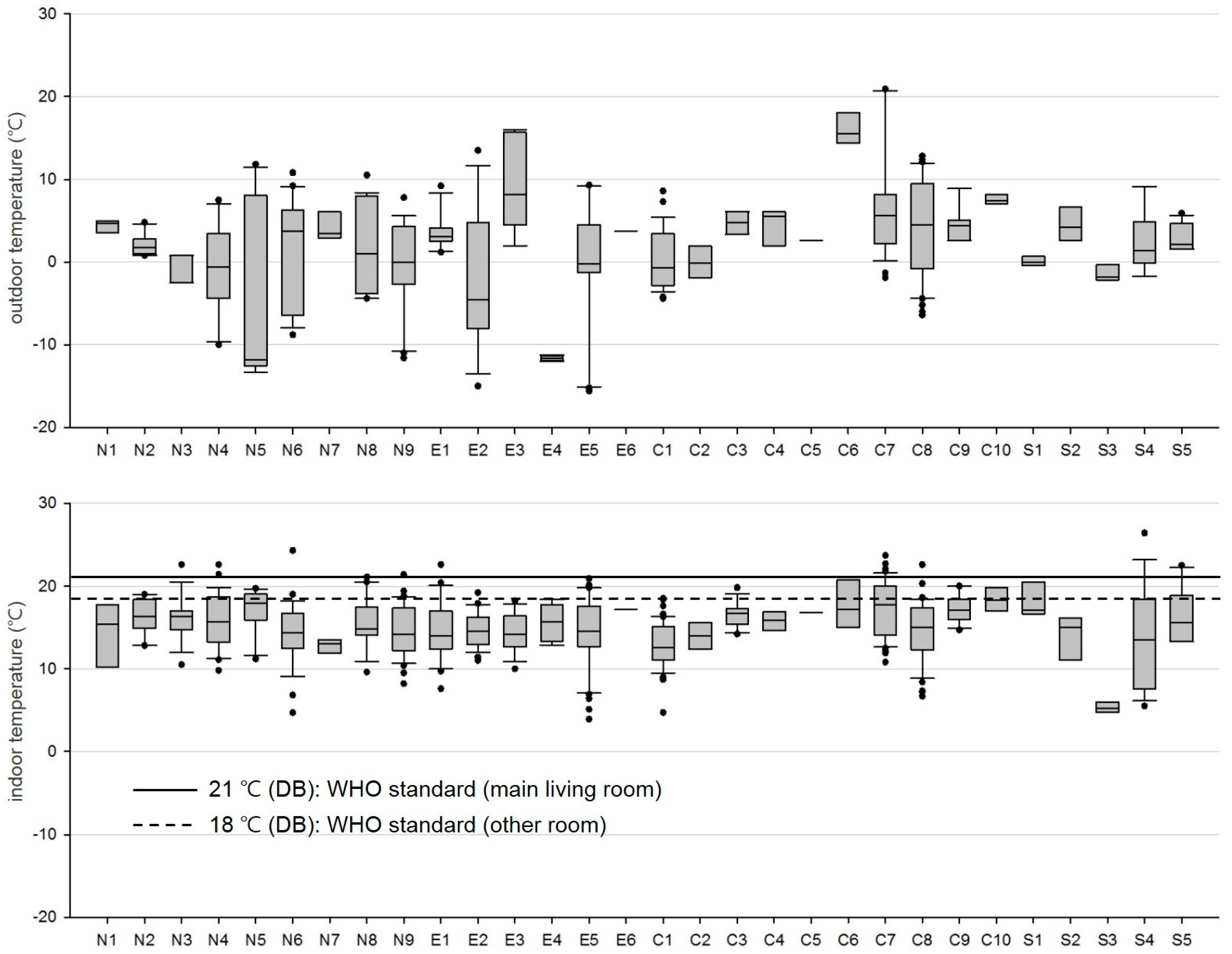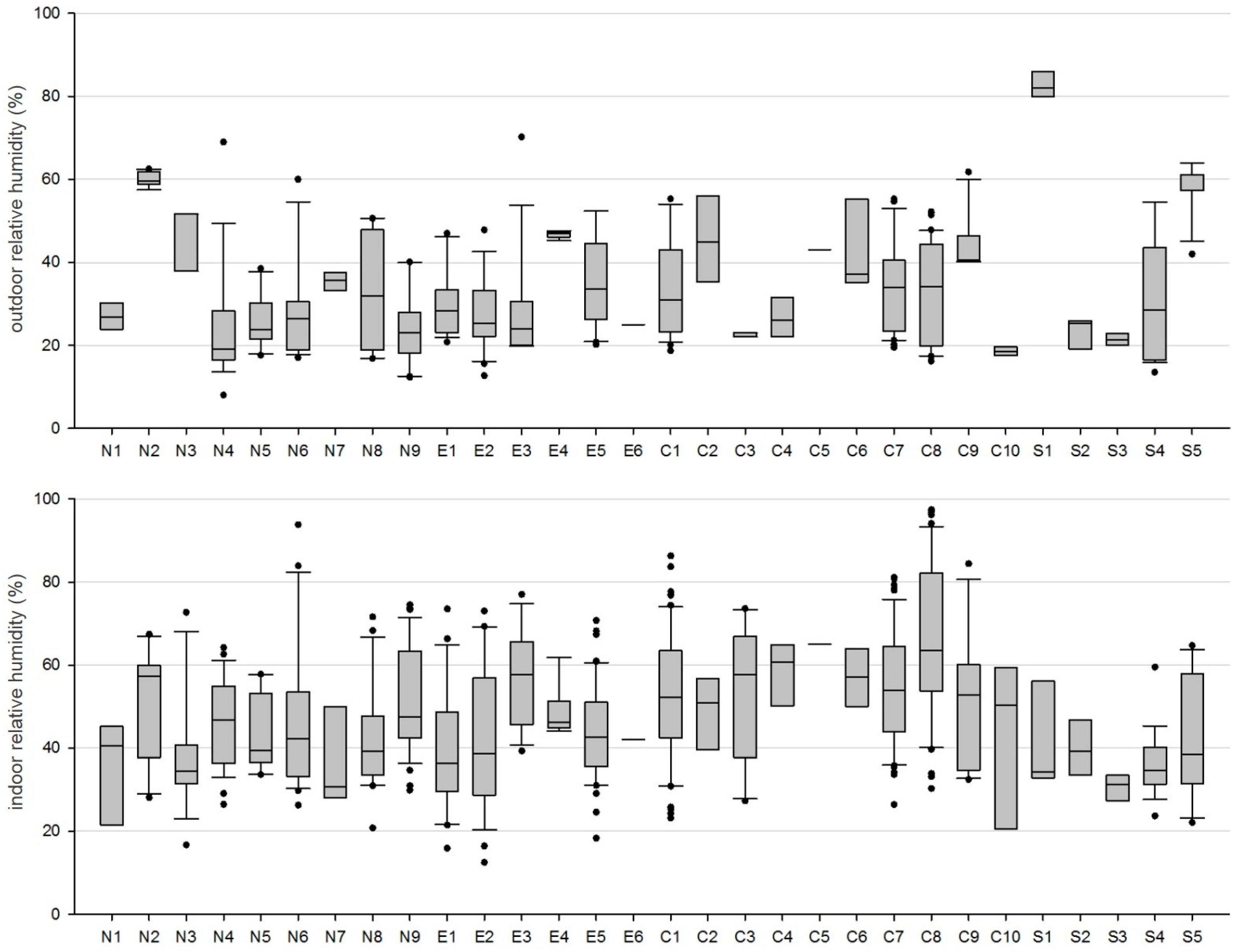The Effect of an Energy Refurbishment Scheme on Adequate Warmth in Low-income Dwellings
Abstract
1. Introduction
2. Methods
2.1. Fuel Poverty Programs in Korea
- Provision and energy efficiency program:
- -
- Residential energy efficiency for low-income households
- -
- Electricity efficiency (high-efficiency lighting)
- -
- New renewable energy facilities for National Rental Housing
- -
- Provision of new renewable energy for welfare facilities
- -
- Safety checks on general-use electrical installations
- -
- Improving the gas system for low-income and near-poor households.
- Energy bill discount program:
- -
- Utility (electricity, gas, and district heating) bill discount.
- Energy cost assistant program:
- -
- Heating energy (kerosene) assistance for low-income households
- -
- Coal briquette assistance for low-income households.
2.2. Field Measurements
3. Results
3.1. Thermal Environments of Analyzed Households
3.2. Relationship between Outdoor and Indoor Temperatures
3.3. Thermal Comfort of Residents
4. Discussion
5. Conclusions
Author Contributions
Funding
Conflicts of Interest
References
- Healy, J. Fuel Poverty and Policy in Ireland and the European Union: Policy Institute; Trinity College Dublin: Dublin, Ireland, 2003. [Google Scholar]
- SEAI. A Review of Fuel Poverty and Low Income Housing; Sustainable Energy Authority of Ireland: Dublin, Ireland, 2003. [Google Scholar]
- Dubois, U. From targeting to implementation: The role of identification of fuel poor households. Energy Policy 2012, 49, 107–115. [Google Scholar] [CrossRef]
- Moore, R. Definitions of fuel poverty: Implications for policy. Energy Policy 2012, 49, 19–26. [Google Scholar] [CrossRef]
- Boardman, B. Fuel Poverty: From Cold Homes to Affordable Warmth; Belhaven Press: London, UK, 1991. [Google Scholar]
- Liddell, C.; Morris, C.; McKenzie, S.; Rae, G. Measuring and monitoring fuel poverty in the UK: National and regional perspectives. Energy Policy 2012, 49, 27–32. [Google Scholar] [CrossRef]
- Atanasiu, B.; Kontonasiou, E.; Mariottini, F. Alleviating Fuel Poverty in the EU. Investing in Home Renovation, a Sustainable and Inclusive Solution; Buildings Performance Institute Europe (BPIE): Brussels, Belgium, 2014. [Google Scholar]
- Vilches, A.; Padura, Á.B.; Huelva, M.M. Retrofitting of homes for people in fuel poverty: Approach based on household thermal comfort. Energy Policy 2017, 100, 283–291. [Google Scholar] [CrossRef]
- Chaurey, A.; Kandpal, T.C. Assessment and evaluation of PV based decentralized rural electrification: An overview. Renew. Sustain. Energy Rev. 2010, 14, 2266–2278. [Google Scholar] [CrossRef]
- Li, K.; Lloyd, B.; Liang, X.-J.; Wei, Y.-M. Energy poor or fuel poor: What are the differences? Energy Policy 2014, 68, 476–481. [Google Scholar] [CrossRef]
- Boardman, B. Fixing Fuel Poverty: Challenges and Solutions; Earthscan: London, UK, 2013. [Google Scholar]
- Scott, S.; Lyons, S.; Keane, C.; McCarthy, D.; Tol, R.S. Fuel Poverty in Ireland: Extent, Affected Groups and Policy Issues; Economic and Social Research Institute: Dublin, Ireland, 2008. [Google Scholar]
- Watson, C.; Bolton, P. Warm Front Scheme. Available online: http://www.parliament.uk/business/publications/research /briefingpapers/SN06197/community-energy-savings-programme-cesp (accessed on 22 August 2013).
- UK. DfB, Energy and Industrial Strategy. In Annual Fuel Poverty Statistics Report; Department for Business, Energy & Industrial Strategy: London, UK, 2017. [Google Scholar]
- Hills, J. Getting the measure of fuel poverty: Final Report of the Fuel Poverty Review; Centre for Analysis of Social Exclusion, London School of Economics and Political Science: London, UK, 2012. [Google Scholar]
- Ireland DCCAE. A Strategy to Combat Energy Poverty; Ireland DCCAE: Dublin, Ireland, 2016.
- Healy, J.D.; Clinch, J.P. Clinch: Fuel Poverty in Europe: A Cross Country Analysis Using A New Composite Measurement. In Environmental Studies Research Series Working Papers; University College Dublin: Dublin, Ireland, 2002. [Google Scholar]
- US DoE. Weatherization Assistance Program Briefing Book; US DoE: Washington, DC, USA, 2016.
- US DoE. Weatherization Assistance Program. DOE Weatherization Assistance Program; US DoE: Washington, DC, USA, 2009.
- Tonn, B.E.; Carroll, D.; Pigg, S.; Blasnik, M.; Dalhoff, G.; Berger, J.; Rose, E.; Hawkins, B.; Eisenberg, J.; Ucar, F.; et al. Weatherization Works—Summary of Findings from the Retrospective Evaluation of the US DOE’s Weatherization Assistance Program; Oak Ridge National Lab.(ORNL): Oak Ridge, TN, USA, 2015.
- UK HMsG. Cutting the Cost of Keeping Warm: A Fuel Poverty Strategy for England; UK HMsG: London, UK, 2017. [Google Scholar]
- Fowlie, M.; Greenstone, M.; Wolfram, C. Do Energy Efficiency Investments Deliver? Evidence from the Weatherization Assistance Program. Q. J. Econ. 2018, 133, 1597–1644. [Google Scholar] [CrossRef]
- Green, G.; Gilbertson, J. Warm Front, Better Health: Health Impact Evaluation of the Warm Front Scheme; Sheffield Hallam University: Sheffield, UK, 2008. [Google Scholar]
- Harris, J.; Hall, J.; Meltzer, H.; Jenkins, R.; Oreszczyn, T.; McManus, S. Health, Mental Health and Housing Conditions in England; National Centre for Social Research: London, UK, 2010. [Google Scholar]
- Liddell, C.; Morris, C. Fuel poverty and human health: A review of recent evidence. Energy Policy 2010, 38, 2987–2997. [Google Scholar] [CrossRef]
- Hood, E. Dwelling disparities: How poor housing leads to poor health. Environ. Health Persp. 2005, 113, A310. [Google Scholar] [CrossRef] [PubMed]
- Hong, S.H.; Gilbertson, J.; Oreszczyn, T.; Green, G.; Ridley, I. A field study of thermal comfort in low-income dwellings in England before and after energy efficient refurbishment. Build. Environ. 2009, 44, 1228–1236. [Google Scholar] [CrossRef]
- Standard, A. Standard 55-2013. Thermal Environmental Conditions for Human Occupancy; ASHRAE: Atlanta, GA, USA, 2013. [Google Scholar]
- ISO E. 7730. Ergonomics of the Thermal Environment—Analytical Determination and Interpretation of Thermal Comfort Using Calculation of the PMV and PPD Indices and Local Thermal Comfort Criteria; Standards Norway: Oslo, Norway, 2005. [Google Scholar]
- World Health Organization. Housing, Energy and Thermal Comfort; World Health Organization: Copenhagen, Denmark, 2007. [Google Scholar]
- Critchley, R.; Gilbertson, J.; Grimsley, M.; Green, G.; Group WFS. Living in cold homes after heating improvements: Evidence from Warm-Front, England’s Home Energy Efficiency Scheme. Appl. Energy 2007, 84, 147–158. [Google Scholar] [CrossRef]
- Healy, J.D.; Clinch, J.P. Fuel poverty, thermal comfort and occupancy: Results of a national household-survey in Ireland. Appl. Energy 2002, 73, 329–343. [Google Scholar] [CrossRef]
- Shin, J. Estimation of Fuel-Poverty in Korean Households; Korea Energy Economics Institute: Seoul, Korea, 2011. [Google Scholar]
- Kim, H. Fuel Poverty in Korea and Its Policy Implications; Korean Institute for Health and Social Affairs: Seoul, Korea, 2015. [Google Scholar]
- Lee, T. A Survey Study of Poverty Policy; Korean Institute for Health and Social Affairs: Seoul, Korea, 2011. [Google Scholar]
- Chaudhuri, T.; Soh, Y.C.; Bose, S.; Xie, L.; Li, H. On assuming Mean Radiant Temperature equal to air temperature during PMV-based thermal comfort study in air-conditioned buildings. In Proceedings of the Conference on Assuming Mean Radiant Temperature Equal to Air Temperature during PMV-Based Thermal Comfort Study in Air-Conditioned Buildings, Florence, Italy, 23–26 October 2016; pp. 7065–7070. [Google Scholar]
- Langner, M.; Scherber, K.; Endlicher, W.R. Indoor heat stress: An assessment of human bioclimate using the UTCI in different buildings in Berlin. ERDE 2014, 144, 260–273. [Google Scholar]
- Bae, C.; Chun, C. Research on seasonal indoor thermal environment and residents’ control behavior of cooling and heating systems in Korea. Build. Environ. 2009, 44, 2300–2307. [Google Scholar] [CrossRef]
- Anderson, W.; White, V.; Finney, A. Coping with low incomes and cold homes. Energy Policy 2012, 49, 40–52. [Google Scholar] [CrossRef]
- Pignatta, G.; Chatzinikola, C.; Artopoulos, G.; Papanicolas, C.N.; Serghides, D.K.; Santamouris, M. Analysis of the indoor thermal quality in low income Cypriot households during winter. Energy Build. 2017, 152, 766–775. [Google Scholar] [CrossRef]
- iPHA. Certified Passive House; International Passive House Association: Darmstadt, Germany, 2013. [Google Scholar]
- Yoshino, H.; Yoshino, Y.; Zhang, Q.; Mochida, A.; Li, N.; Li, Z.; Miyasaka, H. Indoor thermal environment and energy saving for urban residential buildings in China. Energy Build. 2006, 38, 1308–1319. [Google Scholar] [CrossRef]










| Energy Spending as % of Disposable Income | 2010 | 2011 | 2012 | 2013 |
|---|---|---|---|---|
| 10% and more | 1,646,353 | 1,630,908 | 1,748,064 | 1,780,824 |
| 20% and more | 606,763 | 596,180 | 556,742 | 614,249 |
| Fuel Cost/Disposable Income | ||||
|---|---|---|---|---|
| 2010 | 2011 | 2012 | 2013 | |
| 1st decile | 19.6% | 20.6% | 21.1% | 21.0% |
| 2nd decile | 8.1% | 8.2% | 8.3% | 8.5% |
| 10th decile | 1.8% | 1.8% | 1.7% | 1.7% |
| 2007 | 2008 | 2009 | 2010 | 2011 | 2012 | 2013 | 2014 | 2015 | 2016 | |
|---|---|---|---|---|---|---|---|---|---|---|
| Number of benefited households | 16,501 | 80,130 | 68,331 | 43,336 | 21,428 | 29,628 | 63,508 | 42,158 | 40,707 | 29,468 |
| Budget, KRW million | 10,000 | 28,500 | 28,500 | 29,200 | 19,450 | 29,580 | 41,080 | 67,110 | 61,270 | 48,900 |
| (USD million) | (10.00) | (28.50) | (28.50) | (29.20) | (19.45) | (29.58) | (41.08) | (67.11) | (61.27) | (48.90) |
| Instrument | Specification | |
|---|---|---|
| Temperature | Relative Humidity | |
| Testo 175 H1 | Measurement range of −20 to + 55 °C, accuracy of ± 0.4 °C, resolution is 0.1 °C. | Measurement range of 0 to 100%RH, accuracy of ± 2%RH, resolution is 0.1%RH. |
© 2019 by the authors. Licensee MDPI, Basel, Switzerland. This article is an open access article distributed under the terms and conditions of the Creative Commons Attribution (CC BY) license (http://creativecommons.org/licenses/by/4.0/).
Share and Cite
Park, S.; Kim, J.; Song, D. The Effect of an Energy Refurbishment Scheme on Adequate Warmth in Low-income Dwellings. Sustainability 2019, 11, 2574. https://doi.org/10.3390/su11092574
Park S, Kim J, Song D. The Effect of an Energy Refurbishment Scheme on Adequate Warmth in Low-income Dwellings. Sustainability. 2019; 11(9):2574. https://doi.org/10.3390/su11092574
Chicago/Turabian StylePark, Sowoo, Joowook Kim, and Doosam Song. 2019. "The Effect of an Energy Refurbishment Scheme on Adequate Warmth in Low-income Dwellings" Sustainability 11, no. 9: 2574. https://doi.org/10.3390/su11092574
APA StylePark, S., Kim, J., & Song, D. (2019). The Effect of an Energy Refurbishment Scheme on Adequate Warmth in Low-income Dwellings. Sustainability, 11(9), 2574. https://doi.org/10.3390/su11092574






